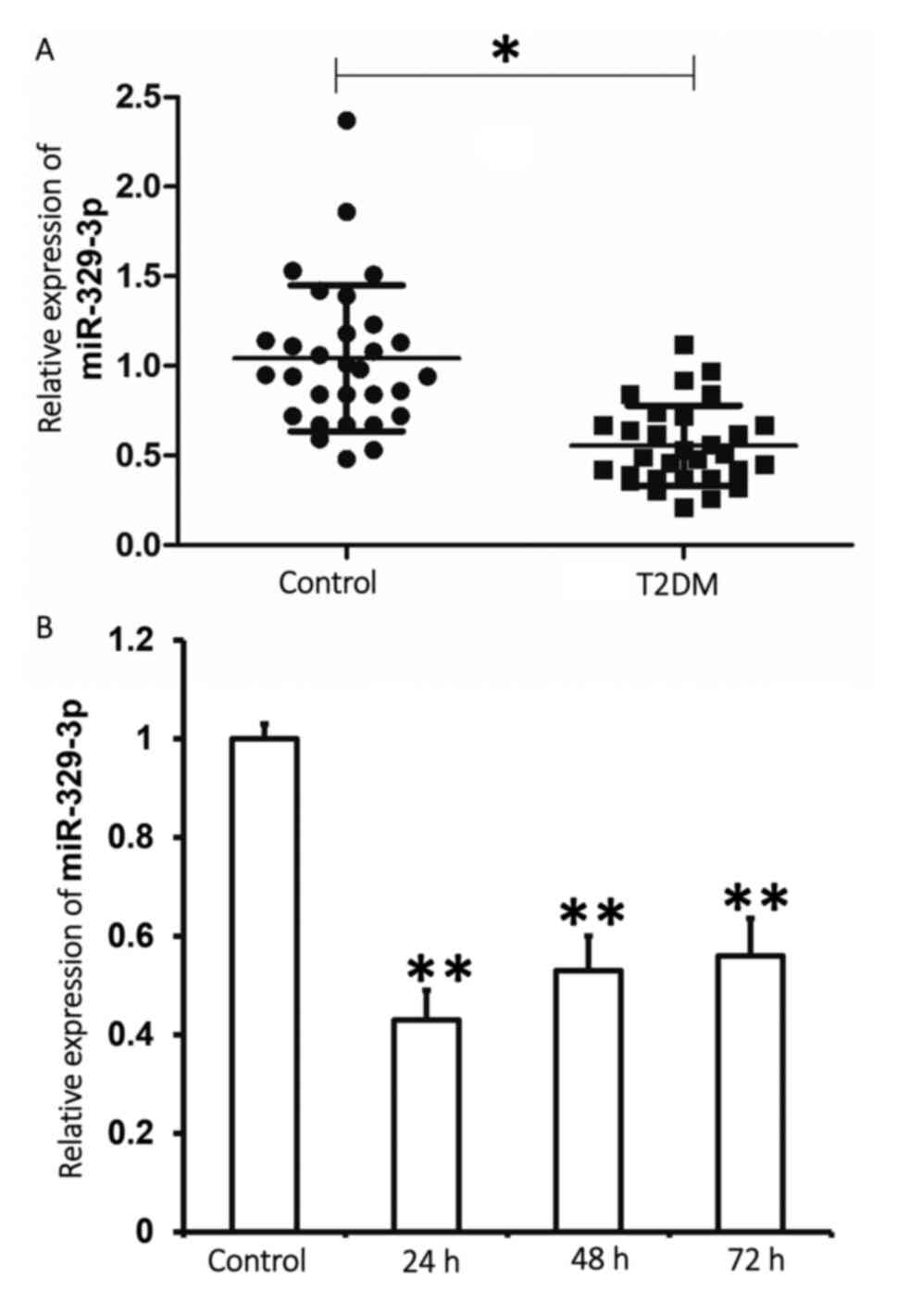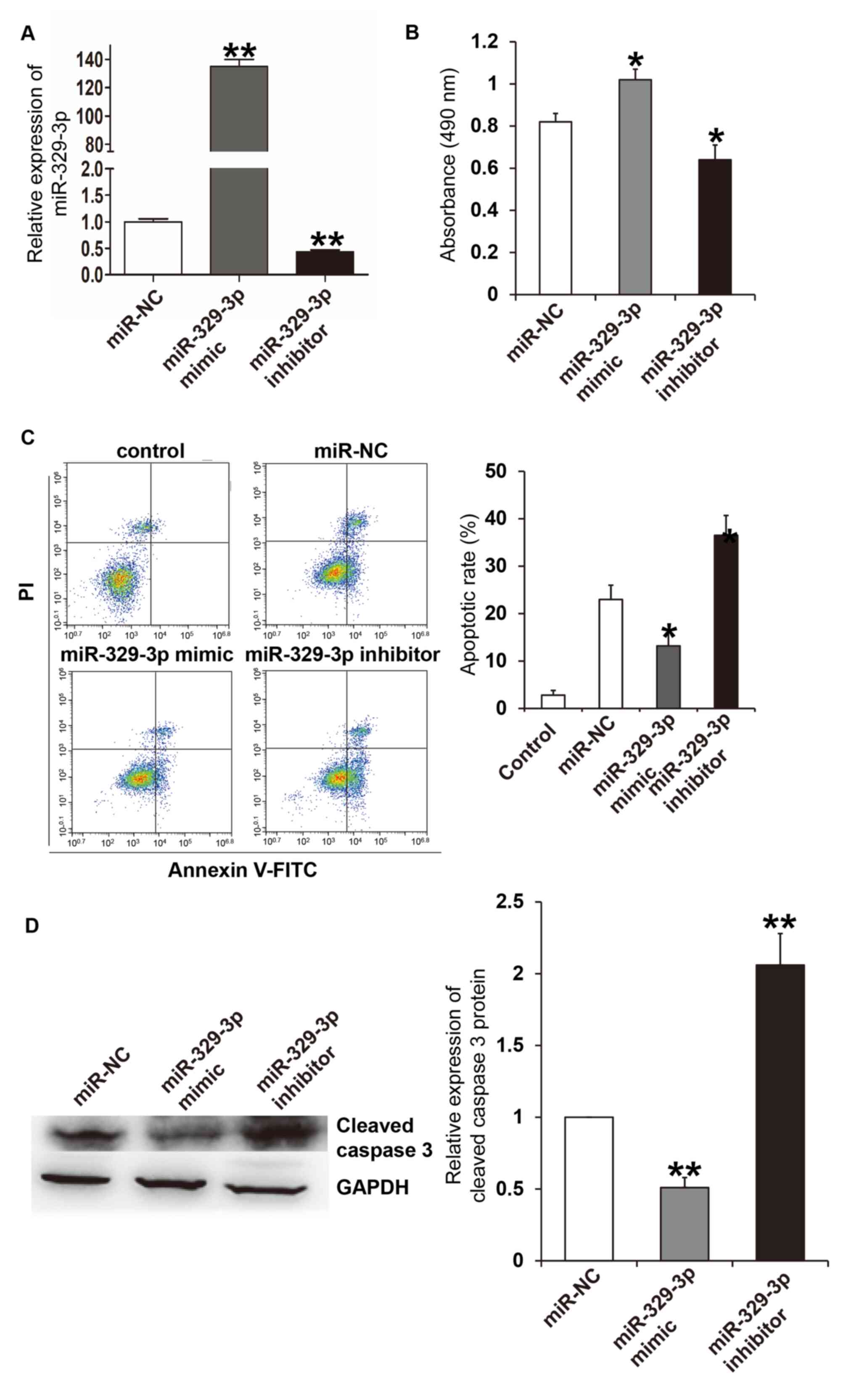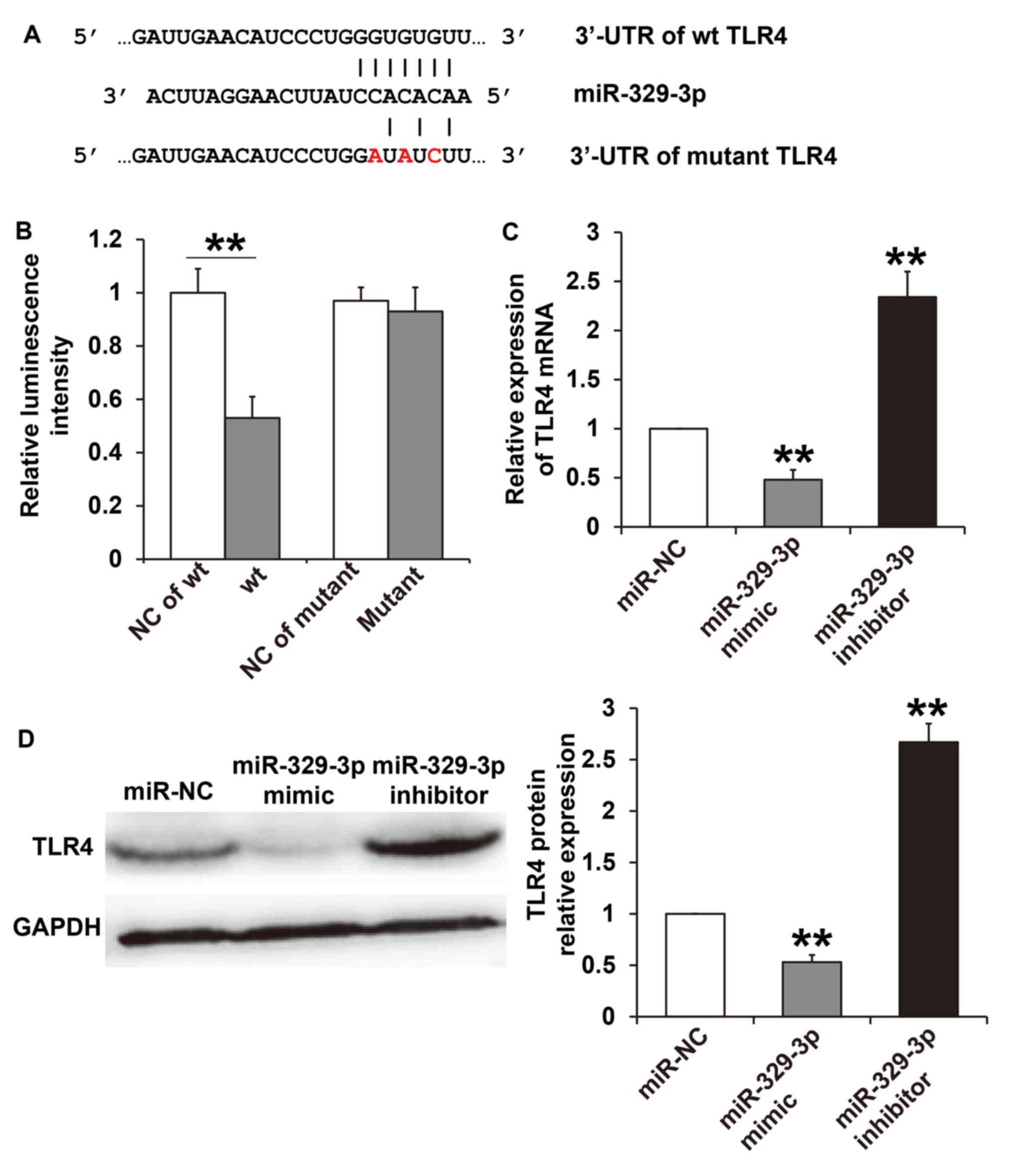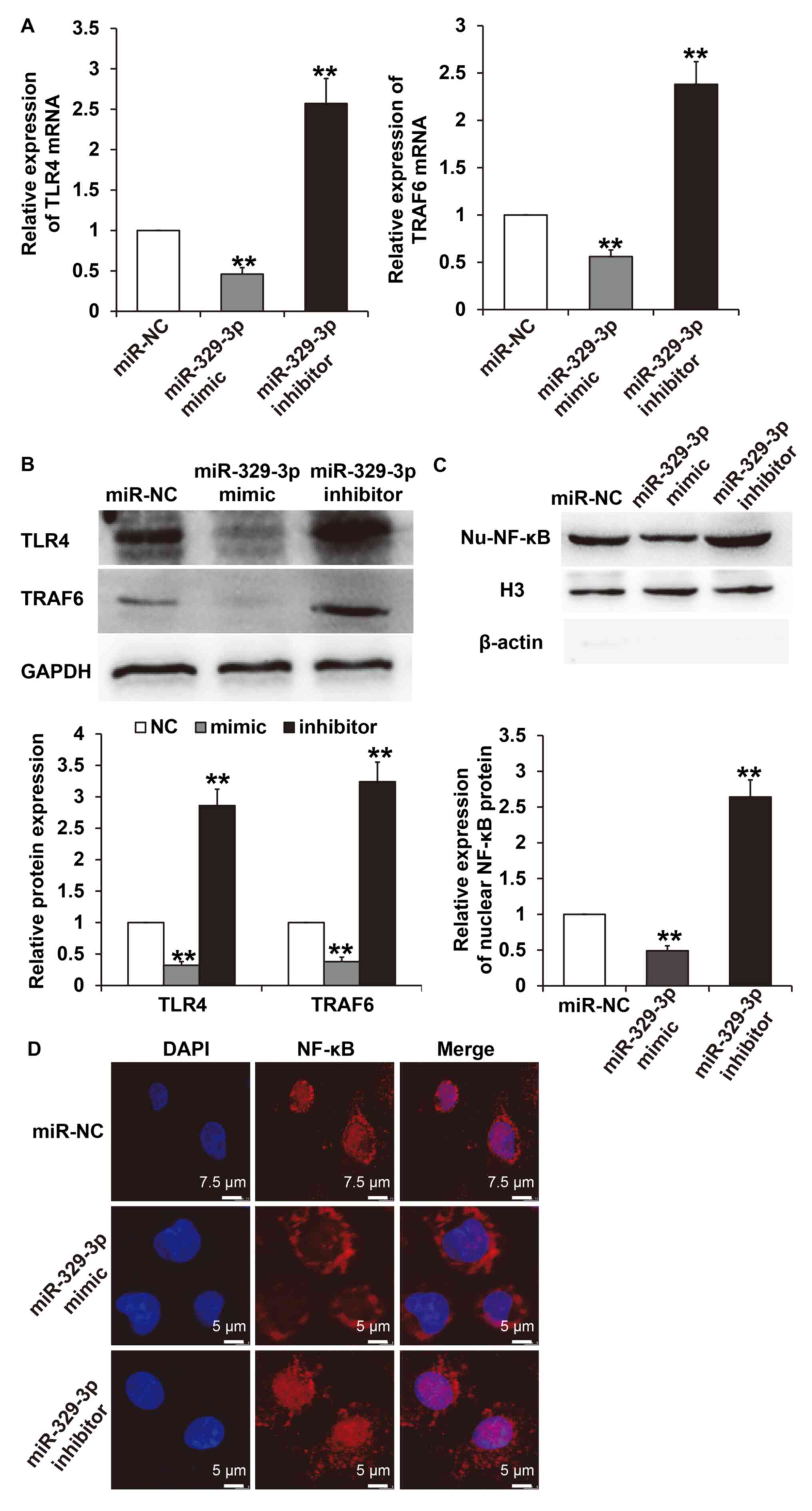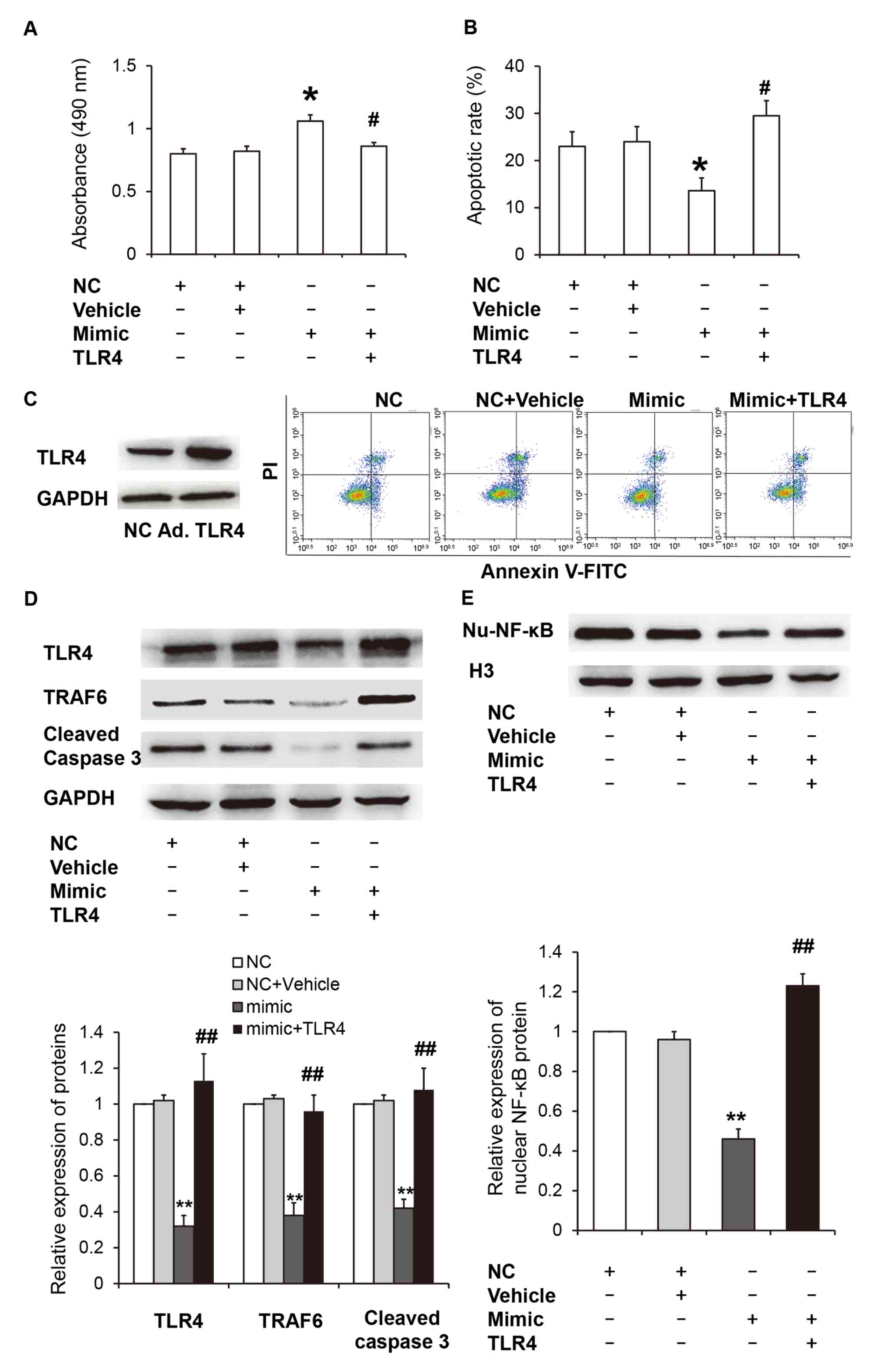MicroRNA‑329‑3p alleviates high glucose‑induced endothelial cell injury via inhibition of the TLR4/TRAF6/NF‑κB signaling pathway
- Authors:
- Published online on: November 10, 2020 https://doi.org/10.3892/etm.2020.9461
- Article Number: 29
-
Copyright: © Song et al. This is an open access article distributed under the terms of Creative Commons Attribution License.
Abstract
Introduction
Diabetes mellitus is a lifelong metabolic disease with a variety of causes, and is characterized by chronic hyperglycemia (1). Diabetic angiopathy is a common complication in patients with diabetes mellitus and is one of the main causes of disability and mortality (1). Vascular endothelial cells are single-layer cells of the vascular intima that serve important roles in the maintenance of vascular structure and function (2). It has been demonstrated that vascular endothelial dysfunction may represent the pathophysiological basis for diabetic angiopathy (2). Hyperglycemia can damage vascular endothelial cell function through a variety of mechanisms, including inflammation, oxidative stress and apoptosis (2). High rates of apoptosis in endothelial cells can lead to a series of complex chain reactions, including the release of interleukin-1, cytochrome C and other active substances, which promote the inflammatory response and aggravate vascular damage (2-4).
MicroRNAs (miRNAs/miRs) are a class of non-coding RNAs between 18 and 22 base pairs in length. These molecules bind to the 3'-untranslated region (UTR) of target genes to regulate their expression, which subsequently affects various biological processes within the cell (5). It has been demonstrated that miRNA molecules are associated with endothelial cell injury under high-glucose conditions. For instance, miR-503 can inhibit endothelial cell proliferation and promote apoptosis under high glucose conditions via the insulin like growth factor 1 receptor (6). Additionally, miR-145 has been revealed to inhibit the oxidative stress and inflammation induced by high glucose in retinal endothelial cells (7). miR-329-3p is a member of the 14q32 miRNA gene cluster (8). A variety of 14q32 miRNA molecules have been demonstrated to serve a role in cardiovascular disease, regulate the interaction between focal adhesion plaques and the extracellular matrix, and serve roles in vascular remodeling (9). Welten et al (10) demonstrated that downregulation of miR-329-3p promotes vascular endothelial cell proliferation and restores blood flow in the ischemic lower limbs of mice. In addition, Wang et al (11) revealed that miR-329-3p inhibited angiogenesis by targeting cluster of differentiation 146. However, to the best of the authors' knowledge, the expression of miR-329-3p in diabetes mellitus, and whether miR-329-3p may be involved in the regulation of high glucose-induced vascular endothelial cell injury, has not yet been investigated.
Toll like receptor (TLR) 4 is a transmembrane protein that belongs to the pattern recognition receptor family. TLR4 activation induces the intracellular signaling pathway responsible for activating the innate immune system via nuclear factor (NF)-κB (12). A number of studies have demonstrated that the TLR4/NF-κB signaling pathway serves a critical role in high glucose-induced inflammation and apoptosis in retinal ganglion cells, retinal microvascular endothelial cells and human retinal endothelial cells (13-15). Welten et al (10) revealed that downregulation of miR-329-3p leads to reduced TLR4 mRNA in a lower limb ischemic mouse model (10). However, the association between miR-329-3p and the TLR4/NF-κB signaling pathway in endothelial cells under high-glucose condition is unclear. Therefore, miR-329-3p expression in patients with type 2 diabetes mellitus (T2DM) and the effect of miR-329-3p on vascular endothelial cell function under high glucose conditions was investigated in the present study.
Materials and methods
Patients
A total of 31 patients (sex, 16 males and 15 females; mean age, 58±7.1 years) who were diagnosed with T2DM at The First People's Hospital of Jinan (Shandong, China) between January 2016 and January 2018 were included in the present study. In addition, a total of 33 healthy subjects with similar sex ratio and mean age (16 males and 17 females; mean age, 56±6.4 years old) who underwent a physical examination at The First People's Hospital of Jinan in the same time period were included as the control group. The inclusion criteria for patients with T2DM were: A fasting blood glucose level of ≥7.0 mmol/l or a 2 h postprandial blood glucose level of ≥11.1 mmol/l. The inclusion criteria for the control group were as follows: i) Contemporaneous healthy subjects undertaking physical examinations; ii) without diabetes; iii) without dyslipidemia and; iv) no history of hypertension or vascular disease. The exclusion criteria were: i) Subjects exhibited signs or symptoms of infection; ii) had received drugs that affected glucose metabolism; iii) presented with liver or kidney failure; or iv) had a history of malignant tumors. Peripheral blood (3 ml) was collected and transferred to anticoagulant tubes prior to plasma separation via centrifugation at 3,000 x g and 4˚C for 10 min. Separated plasma samples were stored in aliquots of 500 µl at -80˚C prior to subsequent use. All procedures performed in the current study were approved by the Ethics Committee of The First People's Hospital of Jinan. Written informed consent was obtained from all patients or their families.
Cells and transfection
Human umbilical vein endothelial cells (HUVECs) were cultured in endothelial cell medium supplemented with 5% FBS and 1% endothelial cell growth factor (all purchased from ScienCell Research Laboratories, Inc.) at 37˚C and 5% CO2. Cells in the high-glucose group were treated with 25 mmol/l glucose for 24, 48 or 72 h to simulate a high-glucose environment in the body. Control group cells were treated with 25 mmol/l D-mannose for 24, 48 or 72 h (Sigma-Aldrich; Merck KGaA) (6,14).
HUVECs in the miR-329-3p mimic group, miR-329-3p inhibitor and miRNA negative control (NC) groups were transfected with 50 nmol/l miR-329-3p mimic, 100 nmol/l miR-329-3p inhibitor (Guangzhou RiboBio Co., Ltd.) and 50 nmol/l miR-NC (Merck KGaA), respectively, using the riboFECT™ CP kit (Guangzhou RiboBio Co., Ltd.) according to the manufacturer's protocol. Cells were collected for further study after 48 h transfection.
The TLR4 overexpression Ad5 adenovirus and adenovirus with empty vector (negative control) were purchased from Hanbio Biotechnology Co., Ltd. and transfection was performed according to the manufacturer's protocol. For co-transfection with miR-329-3p mimics/miR-NC and TLR4 overexpression vectors, HUVECs were first transfected with TLR4 overexpression adenovirus or adenovirus with empty vector (multiplicity of transfection, 20) for 24 h, following which cells were transfected with miR-329-3p mimics (50 nmol) or miR-NC (50 nmol). Cells were collected for further study 48 h following transfection.
Cell Counting Kit (CCK)-8 assay
HUVECs were seeded at a density of 1,000 cells/well in 96-well plates. At 0, 24, 48 and 72 h, 10 µl CCK-8 reagent (5 g/l; Beyotime Institute of Biotechnology) was mixed with 100 µl complete medium and then added to the cells following which the cells were incubated at 37˚C for 1 h. The absorbance of each well was subsequently measured at 490 nm using a plate reader (Thermo Fisher Scientific, Inc.) and used to chart cell viability. Each group was tested in three replicate wells and the values were averaged.
Flow cytometry
Following transfection and high-glucose treatment, HUVECs (1x106) in each group were washed with pre-cooled PBS twice and subjected to flow cytometry analysis using the Annexin V/FITC Apoptosis Detection kit (BD Biosciences) according to the manufacturer's protocol. Annexin V-positive cells were considered to be early apoptotic cells, while propidium iodide-positive cells were considered to be necrotic cells and double-positive cells were considered to be late apoptotic cells. The data were analyzed using the NovoExpress® software (version 1.2.1; ACEA Biosciences; Agilent Technologies, Inc.).
Reverse transcription-quantitative (RT-q)PCR
Total RNA was extracted from 200 µl plasma using a miRNeasy Serum/Plasma kit (Qiagen GmbH). A total of 3.5 µl spike-in Caenorhabditis elegans miRNA-39 (cel-miR-39; 1.6x108 copies) was used as an external reference to evaluate miRNA extraction from the plasma. RNA was extracted from HUVECs using miRNeasy Mini Kit (Qiagen GmbH) according to the manufacturer's instructions. Extracted total RNA (6 µl) was subjected to RT using the miScript II RT kit (Qiagen GmbH), according to the manufacturer's protocol. The RT reaction conditions were as follows: 37˚C for 60 min, followed by 95˚C for 5 min. A total of 10 µl cDNA solution was subsequently mixed with 100 µl ddH2O prior to RT-qPCR being performed using a ABI StepOne Plus instrument (Thermo Fisher Scientific, Inc.). The reaction system (25 µl) comprised 12.5 µl SYBR Green Master Mix (Qiagen GmbH), 2.5 µl 10X miR-329-3p/cel-miR-39 primers (Qiagen GmbH), 2.5 µl 10X universal primer, 2 µl diluted cDNA and 5.5 µl RNase-free ddH2O. Each sample was tested in triplicate. The thermal cycling parameters for qPCR were as follows: 95˚C for 15 min, followed by 40 cycles of 95˚C for 15 sec, 55˚C for 30 sec and 70˚C for 30 sec.
Total RNA was extracted from cells using TRIzol reagent (Thermo Fisher Scientific, Inc.) according to the manufacturer's protocol. Extracted RNA (500 ng) was subjected to RT and qPCR using a ReverTra Ace® qPCR RT kit (Toyobo Life Science), according to the manufacturer's protocol. The primer sequences used were as follows: Tumor necrosis factor receptor associated factor 6 (TRAF6) forward, 5'-TCTACACTGGCAAACCCG-3', and reverse, 3'-AGGGAGGTGGCTGTCATA-5'; TLR4 forward, 5'-GACCTGTCCCTGAACCCTA-3', and reverse, 3'-TCTCCCAGAACCAAACGA-5'; GAPDH forward, 5'-ATGCTGGCGCTGAGTACGTC-3', and reverse, 3'-GGTCATGAGTCCTTCCACGATA-5'. The 2-ΔΔCq method (16) was used to calculate miR-329-3p expression relative to cel-miR-39, as well as the expression of TRAF6 or TLR4 relative to GAPDH. Each sample was tested in triplicate.
Total protein and nuclear protein isolation
Total protein was extracted using RIPA Lysis Buffer (Beyotime Institute of Biotechnology). To isolate the nuclear protein, 3x106 cells were collected and treated with a Minute Plasma Membrane Protein Isolation kit (Invent Biotechnologies, Inc.) according to the manufacturer's protocol. Cells were lysed using buffer A on ice for 5 min prior to transfer into filtration columns. Centrifugation was performed at 16,000 x g for 30 sec and again at 700 x g for 1 min, both at 4˚C. The sediment contained complete nuclei and was subsequently lysed using RIPA buffer (Beyotime Institute of Biotechnology) on ice for 10 min. Following the addition of 1/4 volumes of 5X SDS-PAGE loading buffer, samples were boiled at 100˚C for 10 min. The protein concentration of total and nuclear protein was using Bicinchoninic Acid Protein Assay Kit (Beyotime Institute of Biotechnology).
Western blot analysis
Protein samples (20 µg) were subjected to 10% SDS-PAGE at 100 V. Proteins were subsequently transferred to PVDF membranes on ice for 1 h (250 mA) and blocked with 5% skimmed milk at room temperature for 1 h. Membranes were subsequently incubated with rabbit anti-human TLR4 (dilution, 1:1,000; cat. no. ab13556; Abcam), rabbit anti-human TRAF6 (dilution, 1:4,000; cat. no. ab181622; Abcam), rabbit anti-human NF-κB (dilution, 1:1,000; cat. no. AF1234; Beyotime Institute of Biotechnology), and rabbit anti-human cleaved caspase-3 (dilution, 1:1,000; cat. no. 9664; Cell Signaling Technology, Inc.) polyclonal primary antibodies, and mouse anti-human GAPDH (dilution, 1:2,000; cat. no. AF0006; Beyotime Institute of Biotechnology), mouse anti-human β-actin (dilution, 1:2,000; cat. no. AF0003; Beyotime Institute of Biotechnology) and mouse anti-human H3 (dilution, 1:1,000; cat. no. AF0009; Beyotime Institute of Biotechnology) monoclonal primary antibodies overnight at 4˚C. After washing with PBS containing Tween-20 in triplicate (15 min each time), membranes were incubated with goat anti-mouse horseradish peroxidase-conjugated IgG (H+L; dilution, 1:3,000; cat. no. A0216; Beyotime Institute of Biotechnology) or goat anti-rabbit horseradish peroxidase-conjugated IgG (H+L; dilution, 1:3,000; cat. no. A0208; Beyotime Institute of Biotechnology) for 1 h at room temperature. The membrane was then developed with an enhanced chemiluminescence detection kit (Sigma-Aldrich; Merck KGaA). Quantity One software (version 4.4.0.36; Bio-Rad Laboratories, Inc.) was used to acquire and analyze imaging signals. The relative target proteins were expressed relative to their respective internal reference proteins.
Laser confocal microscopy
HUVECs were seeded onto polylysine-coated cover slips (diameter, 14 mm). When 40-60% confluence was achieved, the cells were transfected using the aforementioned methods. At 24 h following transfection, cells were treated with high glucose for 24 h. The cells were then fixed with 4% paraformaldehyde for 10 min and treated with 0.2% Triton X-100 for 10 min, both at room temperature. After blocking with 10% goat serum (Sigma-Aldrich; Merck KGaA) for 30 min at room temperature, 50 µl rabbit anti-NF-κB primary antibody was added (dilution, 1:100; cat. no. AF1234; Beyotime Institute of Biotechnology) and the cells were incubated at 4˚C overnight. Samples were then incubated with Cy3-labeled Goat anti-mouse IgG secondary antibody (dilution, 1:500; cat. no. A0521; Beyotime Institute of Biotechnology) at room temperature for 1 h prior to observation using laser confocal microscopy.
Bioinformatics
Bioinformatics-based predictions are a powerful tool for the assessment of miRNA function. In the current study, TargetScan (version no. 7.2; http://www.targetscan.org) was used to predict target genes that may be regulated by miR-329-3p. The targeted genes with at least 7 binding sites with miR-329-3p and those previously reported to play serve roles in HG-induced endothelial dysfunction were given priority.
Dual luciferase reporter assay
According to the bioinformatics analysis, the wild-type (WT) and mutant seed regions (designed to break the binding) of miR-329-3p in the 3'-UTR of the TLR4 gene were chemically synthesized in vitro. To achieve this, the two ends were attached using SpeI and HindIII restriction sites and cloned into pMIR-REPORT luciferase reporter plasmids (Takara Biotechnology Co., Ltd.). Plasmids (0.8 µg) encoding the WT or mutant 3'-UTR sequences were co-transfected with 100 nM agomiR-329-3p (Guangzhou RiboBio Co., Ltd.) into 293T cells (Type Culture Collection of the Chinese Academy of Sciences) using Lipofectamine 3000 (Thermo Fisher Scientific, Inc.). 293T cells were transfected with an agomiR-NC as a control. At 48 h following transfection, the cells were lysed using a dual luciferase reporter assay kit (Promega Corporation) according to the manufacturer's protocol, and the luminescence intensity was measured using a GloMax 20/20 luminometer (Promega Corporation). Using Renilla luminescence activity as an internal reference, the luminescence values of each group of cells were measured.
Statistical analysis
The results were analyzed using SPSS 20.0 statistical software (IBM Corp.). The data were expressed as the mean ± standard deviation. Data were tested for normality. Differences among multiple groups were analyzed by one-way ANOVA. In cases of homogeneity of variance, a least significant difference and Student-Newman-Keuls test were used. In cases of heterogeneity of variance, a Tamhane's T2 or a Dunnett's T3 test was used. Comparisons between two groups were performed using a Student's t-test. P<0.05 was considered to indicate a statistically significant difference.
Results
Plasma miR-329-3p expression is decreased in patients with T2DM and following high-glucose treatment of HUVECs
To determine miR-329-3p expression in human samples and cell lines, RT-qPCR analysis was performed. The results indicated that miR-329-3p expression in the plasma of patients with T2DM was significantly lower when compared with the control group (P<0.01; Fig. 1A). In addition, miR-329-3p expression in HUVECs treated with 25 mmol/l glucose for 24, 48 or 72 h was significantly lower when compared with the control group (P<0.01; Fig. 1B). The results indicate that miR-329-3p expression is lower in the plasma of patients with T2DM and in HUVECs treated with a high glucose concentration.
miR-329-3p reduces high glucose-induced damage to HUVECs
RT-qPCR analysis was performed to assess the efficiency of the miR-329-3p mimic and inhibitor. The results demonstrated that transfection with the miR-329-3p mimic and inhibitor significantly increased and decreased miR-329-3p expression levels compared with the miR-NC group, respectively (P<0.01; Fig. 2A). A CCK-8 assay, flow cytometry and western blot analysis were then performed to assess the effect of miR-329-3p overexpression and inhibition on cell viability and apoptosis in HUVEC cells. The results of the CCK-8 assay indicated that, following treatment with high glucose for 24 h, the absorbance of HUVECs transfected with the miR-329-3p mimic was significantly higher when compared with the NC group (P<0.05), and the absorbance of HUVECs transfected with the miR-329-3p inhibitor was significantly lower compared with the NC group (P<0.05; Fig. 2B). The level of apoptosis was then detected using flow cytometry. The results indicated that for HUVECs cultured under D-mannose conditions (control group), the apoptotic rate was ~2.9±1.2% (Fig. 2C). Following treatment with high glucose concentrations for 24 h, the apoptotic rate of HUVECs transfected with the miR-329-3p mimic was significantly lower compared with the NC group (P<0.05), whereas HUVECs transfected with miR-329-3p inhibitor exhibited a significantly higher apoptotic rate compared with the NC group (P<0.05; Fig. 2C). Consistent with the flow cytometry results, western blot analysis demonstrated that cleaved caspase-3 (an apoptotic marker) expression in HUVECs treated with a high glucose concentration for 24 h and transfected with miR-329-3p mimic, was significantly lower when compared with the NC group (P<0.05). However, HUVECs transfected with the miR-329-3p inhibitor had significantly higher cleaved caspase-3 expression compared with the NC group (P<0.05; Fig. 2D). These results suggest that miR-329-3p reduces high glucose-induced HUVEC cell damage.
miR-329-3p binds directly to TLR4 and regulates its expression at the transcriptional and post-transcriptional level
To understand the mechanisms of miR-329-3p, TargetScan was used to predict target genes of miR-329-3p. The results demonstrated that miR-329-3p has seven complementary binding sites with the 3'-UTR of TLR4 (Fig. 3A). To confirm direct binding of miR-329-3p with the TLR4 3'-UTR, a dual luciferase reporter assay was performed. The results demonstrated that miR-329-3p significantly reduced the luminescence of the WT when compared with the NC group (P<0.05), but had no effect on luminescence in the mutant group (P>0.05; Fig. 3B). RT-qPCR and western blot analyses were performed to assess the effect of miR-329-3p on TLR4 mRNA and protein expression. The results revealed that TLR4 mRNA and protein expression in HUVECs transfected with the miR-329-3p mimic were significantly lower when compared with the miR-NC group (P<0.05). By contrast, TLR4 mRNA and protein expression in HUVECs transfected with the miR-329-3p inhibitor were significantly higher compared with the miR-NC group (P<0.05; Fig. 3C and D). These results indicate that miR-329-3p may directly bind with TLR4 and regulate its expression at the transcriptional and post-transcriptional level.
miR-329-3p regulates HUVEC cell injury under high glucose conditions via the TLR4/TRAF6/NF-κB signaling pathway
To further elucidate the molecular mechanisms by which miR-329-3p regulates endothelial cell injury induced by high glucose, the expression of TLR4 and its downstream signaling molecule, TRAF6, were examined. The results demonstrated that transfection with the miR-329-3p mimic significantly decreased the expression of TLR4 and TRAF6 mRNA in HUVECs when compared with cells transfected with the miR-NC (P<0.05). However, transfection with the miR-329-3p inhibitor increased TLR4 and TRAF6 mRNA expression in HUVECs compared with cells transfected with miR-NC (P<0.05; Fig. 4A). Similarly, western blot analysis indicated that miR-329-3p upregulation inhibited TLR4 and TRAF6 protein expression (P<0.05), while downregulation of miR-329-3p promoted the expression of TLR4 and TRAF6 (P<0.05; Fig. 4B). In addition, nuclear NF-κB protein expression in HUVEC cells transfected with the miR-329-3p mimic was significantly lower compared with the miR-NC group (P<0.05), while expression in HUVEC cells transfected with the miR-329-3p inhibitor was significantly higher compared with the miR-NC group (P<0.05; Fig. 4C). Immunofluorescence results indicated that the upregulation of miR-329-3p markedly decreased the nuclear translocation of NF-κB, while downregulation of miR-329-3p markedly increased NF-κB nuclear translocation (Fig. 4D). These results suggest that miR-329-3p may be involved in regulating the TLR4/TRAF6/NF-κB signaling pathway and NF-κB nuclear translocation under high glucose conditions.
miR-329-3p protects HUVEC cells from high glucose-induced apoptosis via inhibition of the TLR4/TRAF6/NF-κB signaling pathway
Next, TLR4 was overexpressed to determine the effect of miR-329-3p on the TLR4/TRAF6/NF-κB signaling pathway during HUVECs apoptosis under high glucose conditions. CCK-8 assay demonstrated that transfection with the miR-329-3p mimic significantly increased the absorbance of HUVECs compared with the miR-NC group and the empty vector control (vehicle group) (P<0.05), and overexpression of TLR4 significantly reduced the absorbance of HUVECs transfected with the miR-329-3p mimic (P<0.05; Fig. 5A). Flow cytometry analysis revealed that transfection with the miR-329-3p mimic significantly reduced the HUVEC apoptotic rate when compared with the miR-NC and vehicle groups (P<0.05), and overexpression of TLR4 significantly increased the apoptotic rate of HUVECs transfected with the miR-329-3p mimic (P<0.05; Fig. 5B). A TLR4 overexpression adenovirus was used to further elucidate the role of TLR4 in HUVECs under high glucose conditions. The results demonstrated that TLR4 overexpression markedly increased TLR4 protein expression when compared with the negative control (Fig. 5C). Western blot analysis revealed that TLR4, TRAF6 and cleaved caspase-3 protein expression in HUVECs transfected with the miR-329-3p mimic were significantly reduced when compared with the miR-NC group (P<0.05). However, TLR4 overexpression significantly increased TLR4, TRAF6 and cleaved caspase-3 protein expression in HUVECs transfected with the miR-329-3p mimic (P<0.05; Fig. 5D). In addition, the expression of nuclear NF-κB protein in HUVECs transfected with the miR-329-3p mimic was significantly reduced when compared with the miR-NC group (P<0.05), while overexpression of TLR4 significantly increased the expression of nuclear NF-κB protein in HUVECs transfected with the miR-329-3p mimic (P<0.05; Fig. 5E). These results indicate that miR-329-3p may protect endothelial cells from high glucose-induced apoptosis via inhibition of the TLR4/TRAF6/NF-κB signaling pathway.
Discussion
Previous studies have demonstrated that the abnormal expression of miRNA is frequently associated with diseases such as diabetes (5,6). miR-329-3p exhibits abnormal expression in a variety of tumors and is associated with tumor stage and prognosis (17-19). Wang et al (17) demonstrated that miR-329-3p expression in pancreatic cancer was reduced and survival rates were decreased in patients with low miR-329-3p expression (17). Jiang et al (18) revealed that miR-329-3p expression is decreased in patients with osteosarcoma, and its expression is correlated with tumor stage (18). Li et al (19) demonstrated that low miR-329-3p expression is exhibited in gastric cancer and glioma, and that upregulation of miR-329-3p can inhibit the proliferation and migration of gastric cancer and glioma cells (20). However, to the best of our knowledge, miR-329-3p expression in patients with diabetes has not yet been reported. In the present study, the results demonstrated that plasma miR-329-3p expression in patients with T2DM, or in HUVECs treated with a high glucose concentration, is decreased when compared with normal controls. This suggests that miR-329-3p may affect T2DM progression by modulating the damaging effects of high glucose on endothelial cells. Future studies will assess whether miR-329-3p expression in patients with T2DM is associated with sex, age or additional factors, using a larger sample size.
TLRs are key transmembrane proteins that transmit extracellular antigen recognition information intracellularly and activate inflammatory responses (21). TLR4 serves an important role in mediating signal transduction and inflammation in a variety of cell types (13). Elevated expression of TLR4 has been observed in peripheral blood mononuclear cells obtained from patients with type 1 and type 2 diabetes (22,23). In clinical and experimental studies (23,24), TLR4 expression in a variety of cell types was observed to be significantly increased under high glucose conditions, which was associated with the occurrence of complications associated with diabetes (24). Welten et al (10) revealed that TLR4 mRNA expression is upregulated in an ischemic lower limb mouse model following downregulation of miR-329-3p. The results obtained in the present study demonstrated that TLR4 is a target gene of miR-329-3p. In addition, downregulation of miR-329-3p increased TLR4 expression and its associated downstream genes, increased the nuclear translocation of NF-κB and increased the apoptotic rate of endothelial cells under high glucose conditions. In addition, upregulation of miR-329-3p protected endothelial cells from the apoptosis induced by high glucose by inhibiting the TLR4 signaling pathway. Overexpression of TLR4 abolished the protective effect of miR-329-3p, which indicated that high glucose stimulation may lead to inhibition of miR-329-3p expression in endothelial cells, activate the TLR4 signaling pathway, promote nuclear translocation of NF-κB, reduce the viability of endothelial cells and enhance apoptosis.
In conclusion, the present study demonstrated that plasma miR-329-3p expression is decreased in patients with T2DM. In addition, miR-329-3p may affect the development of T2DM by regulating the TLR4/TRAF6/NF-κB signaling pathway and high glucose-induced endothelial cell injury. The results of the present study provide experimental evidence for the role of miR-329-3p in high glucose-associated endothelial dysfunction, which may help to understand the role of miRNA in endothelial injury induced by hyperglycemia.
Acknowledgements
Not applicable.
Funding
No funding was received.
Availability of data and materials
The datasets used and/or analyzed during the present study are available from the corresponding author on reasonable request.
Authors' contributions
The final version of the manuscript has been read and approved by all authors and each author considers the manuscript to represent honest work. GS and LL collaborated to design the study and analyzed the data. GS, LL and YY were responsible for performing the experiments. All authors collaborated to interpret the results and develop the manuscript.
Ethical approval and consent to participate
All procedures performed in the current study were approved by the Ethics Committee of The First People's Hospital of Jinan (Shandong, China). Written informed consent was obtained from all patients or their families.
Patient consent for publication
Not applicable.
Competing interests
The authors declare that they have no competing interests.
References
|
Hurlow JJ, Humphreys GJ, Bowling FL and McBain AJ: Diabetic foot infection: A critical complication. Int Wound J. 15:814–821. 2018.PubMed/NCBI View Article : Google Scholar | |
|
Knapp M, Tu X and Wu R: Vascular endothelial dysfunction, a major mediator in diabetic cardiomyopathy. Acta Pharmacol Sin. 40:1–8. 2019.PubMed/NCBI View Article : Google Scholar | |
|
Eelen G, de Zeeuw P, Simons M and Carmeliet P: Endothelial cell metabolism in normal and diseased vasculature. Circ Res. 116:1231–1244. 2015.PubMed/NCBI View Article : Google Scholar | |
|
Nakagami H, Kaneda Y, Ogihara T and Morishita R: Endothelial dysfunction in hyperglycemia as a trigger of atherosclerosis. Curr Diabet Rev. 1:59–63. 2005.PubMed/NCBI View Article : Google Scholar | |
|
Mirra P, Raciti GA, Nigro C, Fiory F, D'Esposito V, Formisano P, Beguinot F and Miele C: Circulating miRNAs as intercellular messengers, potential biomarkers and therapeutic targets for Type 2 diabetes. Epigenomics. 7:653–667. 2015.PubMed/NCBI View Article : Google Scholar | |
|
Hou LJ, Han JJ and Liu Y: Up-regulation of microRNA-503 by high glucose reduces the migration and proliferation but promotes the apoptosis of human umbilical vein endothelial cells by inhibiting the expression of insulin-like growth factor-1 receptor. Eur Rev Med Pharmacol Sci. 22:3515–3523. 2018.PubMed/NCBI View Article : Google Scholar | |
|
Hui Y and Yin Y: MicroRNA-145 attenuates high glucose-induced oxidative stress and inflammation in retinal endothelial cells through regulating TLR4/NF-kappaB signaling. Life Sci. 207:212–218. 2018.PubMed/NCBI View Article : Google Scholar | |
|
Seitz H, Royo H, Bortolin ML, Lin SP, Ferguson-Smith AC and Cavaille J: A large imprinted microRNA gene cluster at the mouse Dlk1-Gtl2 domain. Genome Res. 14:1741–1748. 2004.PubMed/NCBI View Article : Google Scholar | |
|
Benetatos L, Hatzimichael E, Londin E, Vartholomatos G, Loher P, Rigoutsos I and Briasoulis E: The microRNAs within the DLK1-DIO3 genomic region: Involvement in disease pathogenesis. Cell Mol Life Sci. 70:795–814. 2013.PubMed/NCBI View Article : Google Scholar | |
|
Welten SM, Bastiaansen AJ, de Jong RC, de Vries MR, Peters EA, Boonstra MC, Sheikh SP, La Monica N, Kandimalla ER, Quax PH and Nossent AY: Inhibition of 14q32 MicroRNAs miR-329, miR-487b, miR-494, and miR-495 increases neovascularization and blood flow recovery after ischemia. Circ Res. 115:696–708. 2014.PubMed/NCBI View Article : Google Scholar | |
|
Wang P, Luo Y, Duan H, Xing S, Zhang J, Lu D, Feng J, Yang D, Song L and Yan X: MicroRNA 329 suppresses angiogenesis by targeting CD146. Mol Cell Biol. 33:3689–3699. 2013.PubMed/NCBI View Article : Google Scholar | |
|
Vaure C and Liu YL: ‘A comparative review of toll-like receptor 4 expression and functionality in different animal species’. Front Immunol. 5(316)2014.PubMed/NCBI View Article : Google Scholar | |
|
Hu L, Yang H, Ai M and Jiang S: Inhibition of TLR4 alleviates the inflammation and apoptosis of retinal ganglion cells in high glucose. Graefes Arch Clin Exp Ophthalmol. 255:2199–2210. 2017.PubMed/NCBI View Article : Google Scholar | |
|
Ye EA and Steinle JJ: miR-146a attenuates inflammatory pathways mediated by TLR4/NF-κB and TNFα to protect primary human retinal Microvascular endothelial cells grown in high glucose. Mediators Inflamm. 2016(3958453)2016.PubMed/NCBI View Article : Google Scholar | |
|
Zhang TH, Huang CM, Gao X, Wang JW, Hao LL and Ji Q: Gastrodin inhibits high glucose-induced human retinal endothelial cell apoptosis by regulating the SIRT1/TLR4/NF-κBp65 signaling pathway. Mol Med Rep. 17:7774–7780. 2018.PubMed/NCBI View Article : Google Scholar | |
|
Livak KJ and Schmittgen TD: Analysis of relative gene expression data using real-time quantitative PCR and the 2 (-Delta Delta c(T)) method. Methods. 25:402–408. 2001.PubMed/NCBI View Article : Google Scholar | |
|
Wang X, Lu X, Zhang T, Wen C, Shi M, Tang X, Chen H, Peng C, Li H, Fang Y, et al: mir-329 restricts tumor growth by targeting grb2 in pancreatic cancer. Oncotarget. 7:21441–21453. 2016.PubMed/NCBI View Article : Google Scholar | |
|
Jiang W, Liu J, Xu T and Yu X: MiR-329 suppresses osteosarcoma development by downregulating Rab10. FEBS Lett. 590:2973–2981. 2016.PubMed/NCBI View Article : Google Scholar | |
|
Li Z, Yu X, Wang Y, Shen J, Wu WK, Liang J and Feng F: By downregulating TIAM1 expression, microRNA-329 suppresses gastric cancer invasion and growth. Oncotarget. 6:17559–17569. 2015.PubMed/NCBI View Article : Google Scholar | |
|
Xiao B, Tan L, He B, Liu Z and Xu R: MiRNA-329 targeting E2F1 inhibits cell proliferation in glioma cells. J Transl Med. 11(172)2013.PubMed/NCBI View Article : Google Scholar | |
|
Gordon S: Pattern recognition receptors: Doubling up for the innate immune response. Cell. 111:927–930. 2002.PubMed/NCBI View Article : Google Scholar | |
|
Devaraj S, Dasu MR, Rockwood J, Winter W, Griffen SC and Jialal I: Increased toll-like receptor (TLR) 2 and TLR4 expression in monocytes from patients with type 1 diabetes: Further evidence of a proinflammatory state. J Clin Endocrinol Metab. 93:578–583. 2008.PubMed/NCBI View Article : Google Scholar | |
|
Dasu MR, Devaraj S, Park S and Jialal I: Increased toll-like receptor (TLR) activation and TLR ligands in recently diagnosed type 2 diabetic subjects. Diabetes Care. 33:861–868. 2010.PubMed/NCBI View Article : Google Scholar | |
|
Garibotto G, Carta A, Picciotto D, Viazzi F and Verzola D: Toll-like receptor-4 signaling mediates inflammation and tissue injury in diabetic nephropathy. J Nephrol. 30:719–727. 2017.PubMed/NCBI View Article : Google Scholar |



